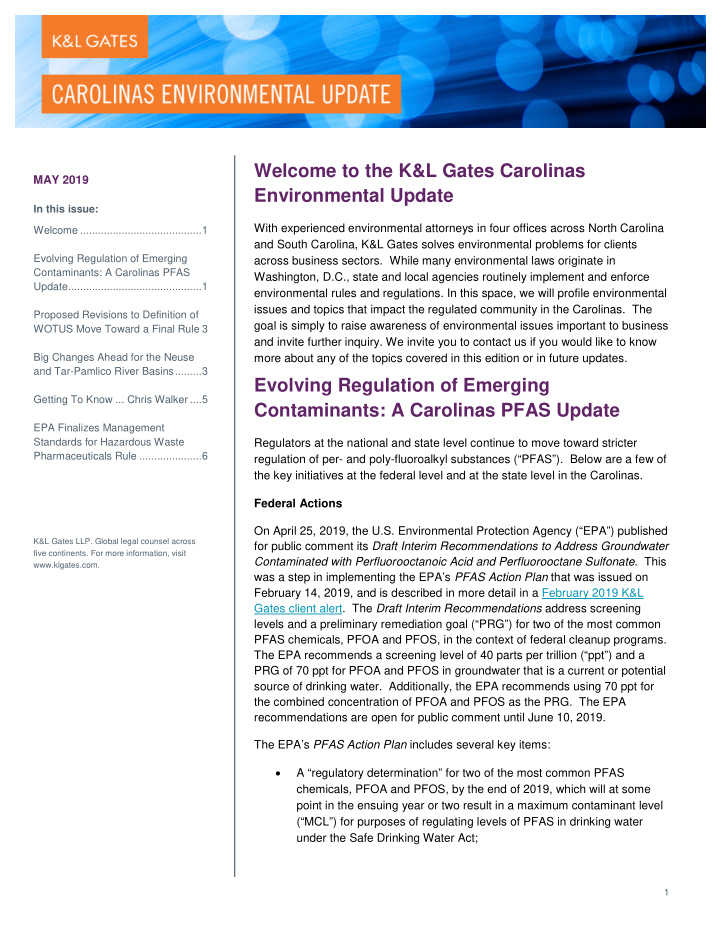



Welcome to the K&L Gates Carolinas MAY 2019 Environmental Update In this issue: With experienced environmental attorneys in four offices across North Carolina Welcome ......................................... 1 and South Carolina, K&L Gates solves environmental problems for clients Evolving Regulation of Emerging across business sectors. While many environmental laws originate in Contaminants: A Carolinas PFAS Washington, D.C., state and local agencies routinely implement and enforce Update ............................................. 1 environmental rules and regulations. In this space, we will profile environmental issues and topics that impact the regulated community in the Carolinas. The Proposed Revisions to Definition of goal is simply to raise awareness of environmental issues important to business WOTUS Move Toward a Final Rule 3 and invite further inquiry. We invite you to contact us if you would like to know Big Changes Ahead for the Neuse more about any of the topics covered in this edition or in future updates. and Tar-Pamlico River Basins ......... 3 Evolving Regulation of Emerging Getting To Know ... Chris Walker .... 5 Contaminants: A Carolinas PFAS Update EPA Finalizes Management Standards for Hazardous Waste Regulators at the national and state level continue to move toward stricter Pharmaceuticals Rule ..................... 6 regulation of per- and poly-fluoroalkyl substances (“PFAS”). Below are a few of the key initiatives at the federal level and at the state level in the Carolinas. Federal Actions On April 25, 2019, the U.S. Environmental Protection Agency (“EPA”) published K&L Gates LLP. Global legal counsel across for public comment its Draft Interim Recommendations to Address Groundwater five continents. For more information, visit Contaminated with Perfluorooctanoic Acid and Perfluorooctane Sulfonate . This www.klgates.com. was a step in implementing the EPA’s PFAS Action Plan that was issued on February 14, 2019, and is described in more detail in a February 2019 K&L Gates client alert. The Draft Interim Recommendations address screening levels and a preliminary remediation goal (“PRG”) for two of the most common PFAS chemicals, PFOA and PFOS, in the context of federal cleanup programs. The EPA recommends a screening level of 40 parts per trillion (“ppt”) and a PRG of 70 ppt for PFOA and PFOS in groundwater that is a current or potential source of drinking water. Additionally, the EPA recommends using 70 ppt for the combined concentration of PFOA and PFOS as the PRG. The EPA recommendations are open for public comment until June 10, 2019. The EPA’s PFAS Action Plan includes several key items: • A “regulatory determination” for two of the most common PFAS chemicals, PFOA and PFOS, by the end of 2019, which will at some point in the ensuing year or two result in a maximum contaminant level (“MCL”) for purposes of regulating levels of PFAS in drinking water under the Safe Drinking Water Act; 1
Carolinas Environmental Update • Listing PFOA and PFOS as “hazardous substances” under the Comprehensive Environmental Response, Compensation, and Liability Act (CERCLA), which would result in PFAS-contaminated properties needing to be remediated for those compounds in addition to any other required remediation; • Adding PFAS chemicals to the Toxic Release Inventory, which would require certain producers of PFAS to disclose their emissions and releases; • Developing further analytical methods and toxicity assessments to improve detection, treatment, and remediation of PFAS; • Using enforcement to address PFAS exposures; and • Developing a “risk communication toolbox” to build trust with the public and communicate risks where scientific conclusions regarding health risks is lacking. Many legislators have expressed disappointment with the EPA’s pacing, and a handful of bills have been introduced to nudge the process, but none of these bills has yet made it out of committee. In the meantime, many states have decided not to rely on the federal government and have taken action on their own initiative. For example, New Jersey set drinking water concentration limits of 13 ppt for PFNA and 14 ppt for PFOA; Vermont issued emergency PFAS drinking water limits of 20 ppt for PFOA, PFOS, PFHxS, PFHpA, and PFNA; and California proposed preliminary notification levels at 14 ppt for PFOA and 13 ppt for PFOS. North Carolina Actions In North Carolina, much of the action lately has been focused on scientific study. The North Carolina Policy Collaboratory, an organization established by the North Carolina General Assembly to leverage practical solutions from the University of North Carolina system, is in the process of conducting a program of statewide water sampling to determine baseline levels of PFAS compounds across the state. Much of the preliminary work of selecting sites and methodologies is complete, and sampling is beginning. In the meantime, several bills have been introduced in the North Carolina General Assembly, but none appear to be gaining traction. Both a ban on PFAS-containing foam and a measure to expand the scope of water discharge regulation to capture more currently unregulated contaminants have been assigned to a committee gauntlet that typically represents a death sentence for any North Carolina bill. Some insiders suspect that a bipartisan bill based on the American Chemistry Council’s model legislation may be introduced, but such a bill does not appear to have been introduced to date. South Carolina Actions The South Carolina General Assembly and South Carolina Department of Health and Environmental Control remain largely silent on PFAS regulation. On the other hand, the U.S. District Court for the District of South Carolina will be the situs of multi-district litigation over aqueous film forming foam (“AFFF”). Jim Joyce Counsel 919.743.7336 jim.joyce@klgates.com 2
Recommend
More recommend